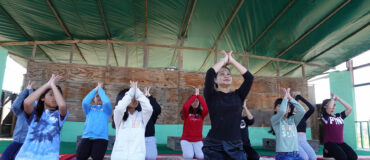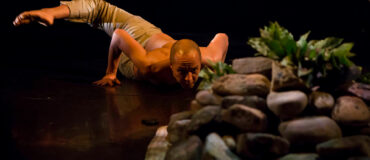The largest festival of Indian classical dance and music outside of India took place earlier this fall in San Francisco and Los Angeles, where thousands gathered for a three-day event in each city. The Chitresh Das Dance Company, a performing arts institution based both in the U.S. and India, spent hundreds of thousands of dollars quite simply to break out of the box and provide Indian artists with a platform that otherwise is rarely represented on mainstream stages.
On October 1, 2010, San Francisco’s mayor, Gavin Newsom, declared Indian Classical Dance and Music Day in San Francisco in conjunction with “Traditions Engaged,” the international festival of classical Indian dance and music. “Traditions Engaged” was presented at Yerba Buena Center for the Arts in San Francisco October 1-3, and a week later, moved to the REDCAT Theatre in Los Angeles, October 8-10, 2010.
More than 100 dancers and musicians, 35 from India and more than 70 from the United States and other countries participated in the programs of performances, lecture/demonstrations, and panel discussions. Evening performances covered the spectrum of eight classical Indian dance and music genres: From the South of India, the elaborate and subtle nuances of kathakali by Sadanam Harikumaran and the esteemed husband-and-wife team, V.P. and Shanta Dhananjayan, in bharatnatyam. From the North and East, styles included the fluid forms of Manipuri and odissi dance, named after their respective places of origin, the rarely seen and newly reconstructed Gaudiya Nritya by Dr. Mahua Mukherjee, the stunning rhythmical improvisation and storytelling of kathak by Pandit Chitresh Das, and the South Indian form of kuchipudi performed by an upcoming dancer.
Indian classical dance is most typically presented on America’s concert stages in one of two ways. There is what is often marketed as “pure” or “authentic” traditional performances of Indian classical dance, meant to show these forms in all their exotic glory and “otherness,” or there is the fusion of Indian forms with Western contemporary techniques, concepts, and aesthetics. This festival relied on neither.
The artists presented at “Traditions Engaged” did not fit in any one box. Most have devoted their lives to classical Indian dance and music and are known as icons in their field. The daytime performances featured next-generation and up-and-coming dancers and musicians. The diversity spanned eight genres. Performers ranged from age 8 to 80 and represented different racial and ethnic backgrounds.
During the daytime panel discussions more questions were raised than answers, highlighting the need for dialogue that is international in scope and brings together audience, the dance community, Indian community and the larger performing arts field. Panel topics ranged from the exploration of the often misunderstood concept of guru in the panel entitled “What Is a Guru?” (the guru shisya parampara, or one-to-one way of learning in front of a guru, is the traditional way to learn all Indian classical dance) — to the philosophical — “Who Does Indian Culture Belong To?”
Throughout the “Traditions Engaged” festival it became apparent that Indian culture belongs to those who are deeply invested in the tenets of promotion, education, and preservation of the art forms, regardless of country of residence, origin, race, creed, or age. Art forms that are considered “culturally specific” are not limited to being performed only by those from the culture of that form, as the festival demonstrated with its multi-ethnic companies and participants. This idea enforces the concept of providing these traditional forms import beyond their countries of origin and illustrates their universal relevance and importance.
What does it mean to preserve an art form? It does not mean passing down the same memorized movement from one generation to the next. A traditional classical art form, which arises from a particular cultural context, in our increasingly global society must adapt and move forward, and these forms, historically, have always evolved. Just as ballet developed from the French and Italian courts, where an emphasis on subtle and refined manners gave way to more dazzling and virtuosic displays in the proscenium context, classical Indian dance, too, has evolved.
Living Breathing Forms
Classical Indian dance forms are “living, breathing forms” that continue to be practiced and experimented with today, used as a vehicle for self-expression and social change. The Indian genres are continually developing forms, like ballet, with ancient roots that continue to hold contemporary relevance. There are many ways that artists are preserving traditions by blending art, entertainment, and culture to reach diverse audiences.
Technology and social media are shrinking and even dissolving the borders of traditional forms. The Indian diaspora has established classical Indian dance throughout the world. So, what does it mean to belong to this culture when Indian dances and music are no longer “made in India”? What does it mean to preserve these traditions?
Many artists in India and abroad are expanding their audiences and genres through collaboration and innovation. One such collaboration is “India Jazz Suites.” Pandit Chitresh Das, a kathak dancer, met tapper Jason Samuels Smith at the American Dance Festival’s 2004 “Festival of the Feet.” For the past five years the two have been touring a production in which they showcase their individual styles and then dance together in a dynamic dialogue of pure rhythm and joy. This collaboration is not a fusion of forms, but rather a blueprint for cross-cultural understanding, self-expression, and the transmission of the depth, spontaneity and elation inherent in the element of upaj, hallmarks of both kathak and tap.
For the “Traditions Engaged” festival, choreographer Harikumaran mined the ancient text “Mahabharata” for a little-known story of love, regret, and redemption. He displayed supertitles so that those without the vast knowledge of the meaning of the kathakali mudras (hand gestures) could further understand the storyline, which held forth universal themes and emotions even those uninitiated in kathakali could understand and appreciate. The spectacular costumes and makeup were upstaged only by the intense, refined technique of kathakali and powerful acting.
Dr. Mahua Mukherjee managed to bridge the divide of art, entertainment, and culture in her lecture-demonstration illuminating the little-known tenants of Gaudiya Nritya. Along with her colleague and musician husband, she composed a song that named the 36 different types of pirouettes particular to her art form. They sang and narrated this while the dancers displayed the virtuosic movements.
Shabd, meaning sound or word, is an ensemble piece featuring the Chitresh Das Dance Company, choreographed by Das. The piece presented an innovation within tradition called kathak yoga. Dancers trained in this technique are able to combine traditional elements of the dance to push the boundaries of virtuosity in kathak. And in “Sita Haran,” the all-female cast portrayed traditional characters with an unconventional twist.
Setting Standards
One issue that became clear in the panel discussion “Who Does Indian Culture Belong To?” was the need for standards. Who sets the standards? Historically, in Indian culture, the gurus set the standards an artist must study deeply before one can begin to experiment. Otherwise, we run the risk of dilution or confusion. This was reiterated by many of the artists throughout the festival.
“Traditions Engaged” brought to light the need to provide opportunities for traditional dance artists to present their art in a context that allows for dialogue and exchange. It brought different genres and artists of various ages and backgrounds together to learn and grow. Who does classical Indian dance belong to? The short answer is those of us who are studying, practicing, teaching, and creating within the fence of tradition with the depth, knowledge, and integrity required to find one’s own voice within the tradition. Indian dance belongs to those connected to the past, but interested in and looking to the future.
Charlotte Moraga is a kathak artist, educator, and choreographer. She began her training with Pandit Chitresh Das at San Francisco State University in 1992 and continued to study deeply in the guru-shisya parampara (one-to-one intensive study). Prior to that Moraga was trained in ballet and jazz dance from the age of nine in Florida, Atlanta, and New York. She has toured India many times, both with the Chitresh Das Dance Company and as a solo artist, performing to critical acclaim in Mumbai, Calcutta, Pune, Agra, New Delhi, Madurai, Pondicherry, and Coimbature. She has also performed at many prestigious festivals such as the American Dance Festival, Denpasar Bali Arts Festival, The International Kathak Festival in Chicago, Ali Akbar Khan’s 80th Birthday Gala, World Arts West’s Ethnic Dance Festival, Kathak at the Crossroads International Festival and Symposium and many more. Moraga was awarded a San Francisco Foundation Shenson Performing Arts Fellowship recognizing her artistic excellence and impact on the field of kathak. Last year she received a residency for the Performing Diaspora Project at CounterPulse and a CA$H grant to support that work. She is currently director of the Chhandam Youth Dance Company and a senior instructor at the Chhandam School of Kathak dance. She is also principal dancer of the Chitresh Das Dance Company and is largely responsible for developing its arts education program. Moraga has written several articles about kathak for dance publications such as Dance Spirit, Dance Magazine, Narthaki.com, and In Dance, published by Dancer’s Group.
____
We accept submissions on topics relevant to the field: advocacy, artistic issues, arts policy, community building, development, employment, engagement, touring, and other topics that deal with the business of dance. We cannot publish criticism, single-company season announcements, and single-company or single artist profiles. Additionally, we welcome feedback on articles. If you have a topic that you would like to see addressed or feedback, please contact communications@danceusa.org.
Disclaimer: Opinions expressed in guest posts do not necessarily represent the viewpoints of Dance/USA.





